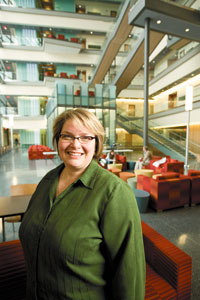Planning for interaction at Institutes for Discovery
As a first-generation college student at a small liberal arts school on the East Coast, Gwen Drury was struck by how physical space influenced the way people interact.
“It seemed easier to make friends in some places than in others,” she says. That observation led to a lifelong fascination with the ways people connect, how those connections are influenced by space and, ultimately, how these interactions influence outcomes.

Gwen Drury poses in the common area of the Microbial Sciences Building. Drury’s Ph.D. thesis focuses on identifying critical architectural and interior design elements that make spaces conducive to interaction. She is working on creating a metric for what she calls “Socially Ergonomic Environmental Design,” a tool that can be used to create spaces that “naturally support people in building community.” As planning coordinator for social interaction space development at the Wisconsin Institutes for Discovery, Drury is working to develop a sense of community in the public spaces at the facility.
Photo: Bryce Richter
Now a Ph.D. student in the School of Education, Drury is identifying the elements of architecture and interior design that make places conducive to interaction. Part of her thesis is creating a metric for what she calls “socially ergonomic environmental Design,” a tool that can be used to create spaces that “naturally support people in building community.” Optimizing design decisions for university campuses and the communities they seek to nurture is at the heart of her research.
As planning coordinator for social interaction space development at the Wisconsin Institutes for Discovery, she is working with the architectural team to ensure the public spaces in the facility will nurture a sense of community within and ensure ties with the outside community, as well. She’s bringing the same expertise to the Wisconsin Union, where she is working on facilities improvement planning for both student unions.
With a master’s degree in student affairs administration, Drury has come to believe that personal connections have a real impact on outcomes. She points to residential learning communities as evidence of that.
“The students in those communities have higher grade point averages and better retention rates than those who aren’t,” Drury says. “A meaningful community makes a big difference.”
As a student affairs coordinator in University Housing from 1991–97, Drury helped create the first residential learning communities. She says at the time it seemed an uncertain endeavor. Would students opt into such a thing?
“The concept has turned out to be such a success, it’s hard for us to imagine that it once felt risky. Schools around the country and even private residence halls in Madison are now adopting this strategy,” Drury says. “It’s all about creating the right social and physical contexts for interaction.”
Drury has become a supporter of the Wisconsin Idea since coming to the state in 1989, and she sees her vocation as integral to ensuring the “knowledge of the university extends to the boundaries of the state.” She believes the better we can connect with each other on campus, the better we can reach out to serve the public good.
Although the Institutes for Discovery are not the first interdisciplinary research program on the Madison campus, the facility is the first to be designed and built around that concept. That raises a lot of questions: What makes a successful interdisciplinary facility? Why are some campus buildings and spaces more dynamic than others? How do buildings and spaces influence interaction?
A key part of the new institutes is a “town center” on the ground floor that welcomes the campus and the public. The architecture team, led by Ballinger Associates of Philadelphia, has worked to achieve the donors’ vision of a sun-filled atrium, complete with food, coffee shop and winter garden — a place where people will want to come and perhaps even linger on a cold or rainy day. Picture the Library Mall if it were inside.
Drury says the facility is meant to be more than a research building; it’s being designed to be a “relationship incubator,” a place where relationships are nurtured on various levels and scales. The research floors will be connected by “communicating stairs” where impromptu conversations can take place and will feature large and small conference rooms, scattered tables and chairs and coffee-break areas for informal interactions.
“We’re trying to create a space where research groups can build strong ties internally and build bridges to the community,” Drury explains. “Many important scientific breakthroughs were the result of innovators ‘bridging distant worlds’ and seeing new opportunities as a result. We want to make it as convenient as possible for researchers to build relationships with people they might not otherwise get to know.”
Drury sees the new building and some others on campus as pivotal to the Wisconsin Idea.
“The concept began with Bascom’s idea that there was a moral obligation for the university to serve the state,” she says. Charles Van Hise expanded Bascom’s mandate, not only by establishing outreach programs like UW–Extension, but also by advocating for social centers to be created, according to Drury.
“Though we tend today to focus on sharing expertise, another part of the Wisconsin Idea has always been about bringing people together to look at the world from the widest possible perspective, and building connections between those people,” Drury says. “There was a sense that making campus more social would make ideas flow, and increase productivity.”



